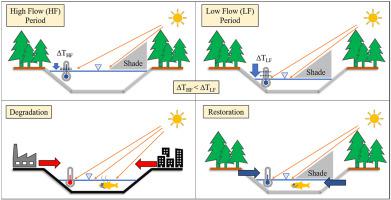Journal of Environmental Management ( IF 8.0 ) Pub Date : 2021-04-12 , DOI: 10.1016/j.jenvman.2021.112560 Reza Abdi , Jennifer B. Rogers , Ashley Rust , Jordyn M. Wolfand , Daniel Philippus , Kristine Taniguchi-Quan , Katie Irving , Eric D. Stein , Terri S. Hogue

|
Managing river temperature in highly urbanized stream systems is critical for maintaining aquatic ecosystems and associated beneficial uses. In this work, we updated and utilized a mechanistic river temperature model, i-Tree Cool River, to evaluate the cooling impacts of two ecological restoration scenarios: (1) an alternative streambed material limecrete and (2) shading effects of tree planting in riparian areas. The i-Tree Cool River model was modified to account for diurnal fluctuations of streambed temperature, which is relevant in shallow urban streams where lack of natural shading combined with low heat capacity of the water column can make diurnal fluctuations relatively extreme. The model was calibrated and validated on a 4.2 km reach of Compton Creek in the Los Angeles River watershed, California. Two native fish, arroyo chub (Gila orcuttii) and unarmored threespine stickleback (Gasterosteus aculeatus williamsoni), were considered the target species for assessing thermal habitat suitability. Key findings include: (1) model performance was improved when accounting for diurnal fluctuations in bed temperature (R2 increased from 0.43 to 0.68); and (2) substrate rehabilitation and tree planting can potentially reduce summertime temperatures to within the documented spawning temperature thresholds for the focal fish species. Using limecrete as an alternative material for the concrete bottom decreased the median river temperature metrics: maximum weekly maximum, maximum weekly average, and minimum weekly minimum temperatures by an average of 3 °C (13%) to 20.4 °C, 19.7 °C, and 17.8 °C, respectively. Tree planting in the riparian corridor decreased the average river temperature metrics by an average of 0.9 °C (4%) to 22.7 °C, 22 °C, and 19 °C, respectively. Combining the two scenarios decreased the river temperature metrics by an average of 4 °C (18%) to 18.2 °C. Therefore, water temperature would not be a limiting factor in potential reintroduction of the focal fish species to Compton Creek if restoration were implemented. Implications of this work could be used by urban forest and water managers for restoring thermally polluted rivers in other urban areas.
中文翻译:

模拟基底温度对城市浅水河流生态恢复的热影响
在高度城市化的河流系统中管理河流温度对于维持水生生态系统和相关的有益用途至关重要。在这项工作中,我们更新并利用了机械河温模型i-Tree Cool River来评估两种生态恢复情景的降温影响:(1)替代的流化材料石灰石;(2)河岸植树的遮荫作用地区。修改了i-Tree Cool River模型以解决河床温度的日变化,这与城市浅水流有关,在这些城市中,缺乏自然阴影加上水柱低热容量会使日变化相对极端。在加利福尼亚州洛杉矶河流域的康普顿溪4.2公里的范围内对模型进行了校准和验证。两条本地鱼,arroyo chub(吉拉(Gila orcuttii)和未穿甲三脊背棘(Gasterosteus aculeatus williamsoni)被认为是评估热生境适宜性的目标物种。关键发现包括:(1)考虑到床温的昼夜波动,模型性能得到了改善(R 2从0.43增至0.68);(2)基质修复和植树有可能将夏季温度降低到重点鱼类的产卵温度阈值范围内。使用石灰混凝土作为混凝土底部的替代材料会降低河中温度的中位数:最高每周最高,最高每周平均和最低每周最低温度平均降低3°C(13%)至20.4°C,19.7°C,和17.8°C。河岸走廊的树木种植使平均河温指标分别降低了0.9°C(4%),分别降至22.7°C,22°C和19°C。结合这两种情况,河流温度指标平均降低4°C(18%)至18.2°C。所以,如果实施恢复措施,水温将不会成为将主要鱼类重新引入康普顿河的限制因素。城市森林和水资源管理者可以利用这项工作来修复其他城市地区的受热污染的河流。











































 京公网安备 11010802027423号
京公网安备 11010802027423号